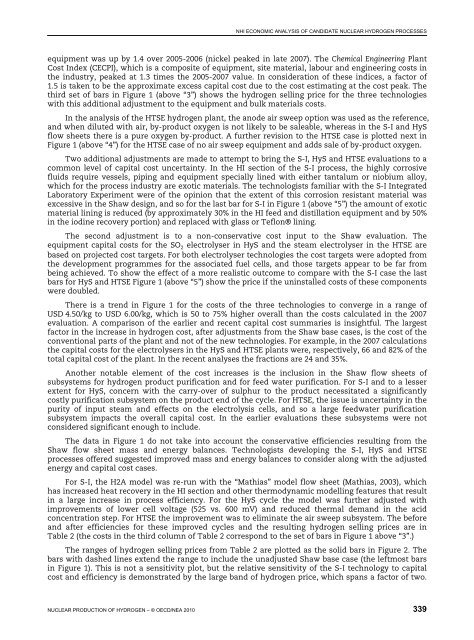Nuclear Production of Hydrogen, Fourth Information Exchange ...
Nuclear Production of Hydrogen, Fourth Information Exchange ...
Nuclear Production of Hydrogen, Fourth Information Exchange ...
Create successful ePaper yourself
Turn your PDF publications into a flip-book with our unique Google optimized e-Paper software.
NHI ECONOMIC ANALYSIS OF CANDIDATE NUCLEAR HYDROGEN PROCESSES<br />
equipment was up by 1.4 over 2005-2006 (nickel peaked in late 2007). The Chemical Engineering Plant<br />
Cost Index (CECPI), which is a composite <strong>of</strong> equipment, site material, labour and engineering costs in<br />
the industry, peaked at 1.3 times the 2005-2007 value. In consideration <strong>of</strong> these indices, a factor <strong>of</strong><br />
1.5 is taken to be the approximate excess capital cost due to the cost estimating at the cost peak. The<br />
third set <strong>of</strong> bars in Figure 1 (above “3”) shows the hydrogen selling price for the three technologies<br />
with this additional adjustment to the equipment and bulk materials costs.<br />
In the analysis <strong>of</strong> the HTSE hydrogen plant, the anode air sweep option was used as the reference,<br />
and when diluted with air, by-product oxygen is not likely to be saleable, whereas in the S-I and HyS<br />
flow sheets there is a pure oxygen by-product. A further revision to the HTSE case is plotted next in<br />
Figure 1 (above “4”) for the HTSE case <strong>of</strong> no air sweep equipment and adds sale <strong>of</strong> by-product oxygen.<br />
Two additional adjustments are made to attempt to bring the S-I, HyS and HTSE evaluations to a<br />
common level <strong>of</strong> capital cost uncertainty. In the HI section <strong>of</strong> the S-I process, the highly corrosive<br />
fluids require vessels, piping and equipment specially lined with either tantalum or niobium alloy,<br />
which for the process industry are exotic materials. The technologists familiar with the S-I Integrated<br />
Laboratory Experiment were <strong>of</strong> the opinion that the extent <strong>of</strong> this corrosion resistant material was<br />
excessive in the Shaw design, and so for the last bar for S-I in Figure 1 (above “5”) the amount <strong>of</strong> exotic<br />
material lining is reduced (by approximately 30% in the HI feed and distillation equipment and by 50%<br />
in the iodine recovery portion) and replaced with glass or Teflon® lining.<br />
The second adjustment is to a non-conservative cost input to the Shaw evaluation. The<br />
equipment capital costs for the SO 2 electrolyser in HyS and the steam electrolyser in the HTSE are<br />
based on projected cost targets. For both electrolyser technologies the cost targets were adopted from<br />
the development programmes for the associated fuel cells, and those targets appear to be far from<br />
being achieved. To show the effect <strong>of</strong> a more realistic outcome to compare with the S-I case the last<br />
bars for HyS and HTSE Figure 1 (above “5”) show the price if the uninstalled costs <strong>of</strong> these components<br />
were doubled.<br />
There is a trend in Figure 1 for the costs <strong>of</strong> the three technologies to converge in a range <strong>of</strong><br />
USD 4.50/kg to USD 6.00/kg, which is 50 to 75% higher overall than the costs calculated in the 2007<br />
evaluation. A comparison <strong>of</strong> the earlier and recent capital cost summaries is insightful. The largest<br />
factor in the increase in hydrogen cost, after adjustments from the Shaw base cases, is the cost <strong>of</strong> the<br />
conventional parts <strong>of</strong> the plant and not <strong>of</strong> the new technologies. For example, in the 2007 calculations<br />
the capital costs for the electrolysers in the HyS and HTSE plants were, respectively, 66 and 82% <strong>of</strong> the<br />
total capital cost <strong>of</strong> the plant. In the recent analyses the fractions are 24 and 35%.<br />
Another notable element <strong>of</strong> the cost increases is the inclusion in the Shaw flow sheets <strong>of</strong><br />
subsystems for hydrogen product purification and for feed water purification. For S-I and to a lesser<br />
extent for HyS, concern with the carry-over <strong>of</strong> sulphur to the product necessitated a significantly<br />
costly purification subsystem on the product end <strong>of</strong> the cycle. For HTSE, the issue is uncertainty in the<br />
purity <strong>of</strong> input steam and effects on the electrolysis cells, and so a large feedwater purification<br />
subsystem impacts the overall capital cost. In the earlier evaluations these subsystems were not<br />
considered significant enough to include.<br />
The data in Figure 1 do not take into account the conservative efficiencies resulting from the<br />
Shaw flow sheet mass and energy balances. Technologists developing the S-I, HyS and HTSE<br />
processes <strong>of</strong>fered suggested improved mass and energy balances to consider along with the adjusted<br />
energy and capital cost cases.<br />
For S-I, the H2A model was re-run with the “Mathias” model flow sheet (Mathias, 2003), which<br />
has increased heat recovery in the HI section and other thermodynamic modelling features that result<br />
in a large increase in process efficiency. For the HyS cycle the model was further adjusted with<br />
improvements <strong>of</strong> lower cell voltage (525 vs. 600 mV) and reduced thermal demand in the acid<br />
concentration step. For HTSE the improvement was to eliminate the air sweep subsystem. The before<br />
and after efficiencies for these improved cycles and the resulting hydrogen selling prices are in<br />
Table 2 (the costs in the third column <strong>of</strong> Table 2 correspond to the set <strong>of</strong> bars in Figure 1 above “3”.)<br />
The ranges <strong>of</strong> hydrogen selling prices from Table 2 are plotted as the solid bars in Figure 2. The<br />
bars with dashed lines extend the range to include the unadjusted Shaw base case (the leftmost bars<br />
in Figure 1). This is not a sensitivity plot, but the relative sensitivity <strong>of</strong> the S-I technology to capital<br />
cost and efficiency is demonstrated by the large band <strong>of</strong> hydrogen price, which spans a factor <strong>of</strong> two.<br />
NUCLEAR PRODUCTION OF HYDROGEN – © OECD/NEA 2010 339

















